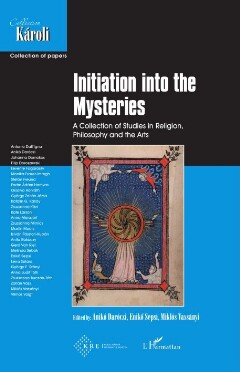Page 303 [303]
DENIALS OF THE DIVINE
eyes disturb him greatly, and covers the parrot and the goldfish, as both have
eyes which grow and look at him. Interestingly, as soon as he blocks these
animals and disturbing factors out of sight, they become non-existent for him
even, though they are physically there. Berkeley’s thesis applies both to the
perceivers and to the perceived. O’s primary aim is to avoid the eyes. In Being
and Nothingness, Sartre examines in detail the notion of “Being-seen-by-the¬
other.” He explains that “of course what most often manifests a look is the
convergence of two ocular globes in my direction. But the look will be given
just as well on occasion when there is a rustling of branches, of the sound of
a footstep followed by silence, or the slight opening of a shutter, or a light
movement of a curtain.””®
While preparing the room in order to ensure that he will be entirely safe,
O catches sight of an old picture hanging on the wall, a worm-like figure with
vestigial arms and bulging eyes. James Knowlson reveals that the photo was
suggested to Beckett by Avigdor Arikha, and it was in fact a reproduction of
the head of Abu, a Sumerian god.”” He destroys God’s image not simply by
tearing the paper off the wall and into four pieces, but also treading repeatedly
on its remains (God’s eyes) on the ground. As Sartre says, “the look which the
eyes manifest, no matter what kind of eyes they are, is a pure reference to
myself. What I apprehend immediately when I hear the branches crackling
behind me is not that there is someone there; it is that | am vulnerable, that
I have a body which can be hurt, that I can occupy a place and that I can not
in any case escape from the space in which I am without defense — in short,
that I am seen.”*® At a later point, O takes out six photos depicting him
always while being observed by others (mother, God, dog, public, young man,
daughter, and the photographer) at different ages from childhood up to the
present, and he tears them up in reverse order one by one. In a letter to Alan
Schneider sent from Paris on 29 June 1964, Beckett explains that “the photos
and their destruction parallel triple perception (human, animal, divine) from
which he seeks to escape and his efforts to obliterate it.”
However, the imprint of God’s destroyed image remains on the wall—a clear,
almost shining white spot with a nail protruding from it, which evokes both
the crucifixion and the resurrection. It is hard to determine the degree of
artistic awareness regarding the divine presence created by Beckett, which
becomes even stronger dramaturgically through the absence of God’s image.
The wound on the wall emerges as a new character in the script, who cannot
6 Sartre, Being and Nothingness, 281. Quoted in Péter Dávidházi, József; Illyés, Jób I., in Holmi,
2008/5. 614.
James Knowlson, Damned to Fame. The Life of Samuel Beckett, New York, Simon and
Schuster, 1996, 465.
°8 Sartre, Being and Nothingness, 282. Quoted in Dävidhäzi, Jözsef, Illyés, Jób I., 614.
9 Harmon, Maurice (ed.), No Author Better Served. The Correspondence of Samuel Beckett and
Alan Schneider, Cambridge, Massachusetts, Harvard University Press, 1998, 159.
27
+ 301 +
Daréczi-Sepsi-Vassänyi_Initiation_155x240.indb 301 ® 2020. 06.15. 11:04:25

